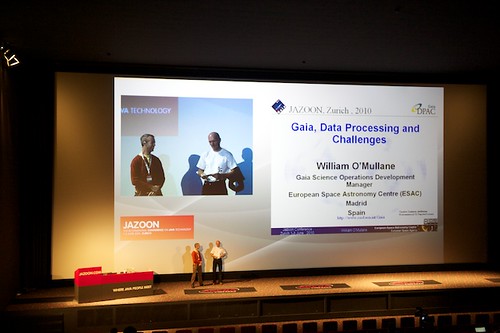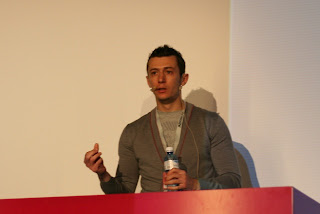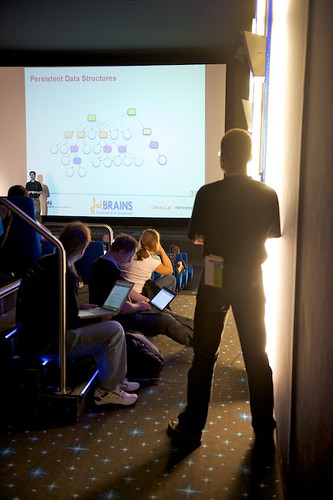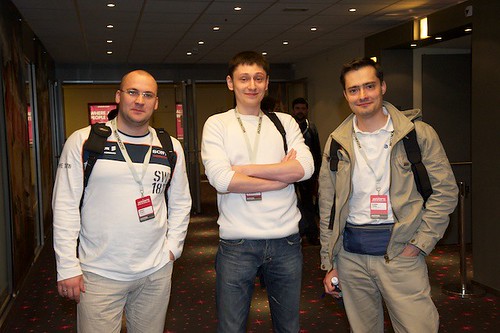The
3rd day at JAZOON 2010 had plenty of good talks in the schedule. The day started with a keynote
"The Gaia satellite and Data Processing" by William O'Mullane from
ESAC.
The main topic of the keynote was about the issues related to the establishment of a satellite carrying a giant telescope, Gaia. He also mentioned that ESAC uses Java for data processing almost exclusively since 2000. Only some scientific numerical calculations are still implemented in Fortran.
From the standpoint of performance, they find the fact that Java is faster than C for an equivalent code, thanks to JIT on an Intel processor. (see the slide photo below) This claim was even noted at
DZone.
The limitations of Java that William noted were:
* "Java is not the tracer bullet"
* too little math libraries maintained (the best being ApacheCommon Math)
* poor IEEE standards compliance
The next talk I attended was about
Abacus Formula Compiler by
Peter Arrenbrecht. The Abacus Formula Compiler is a Java library that enables you to build a spreadsheet functionality into you Java application. It works best if the spreadsheet contains the values and formulas only. Unfortunately it cannot deal with VBA macros. But still, it provides quite a natural way to embed integrate Java with the spreadsheets.
After that I've listened a presentation about
portal evolution in Credit Suisse. A brand new version of the bank's intranet portal was introduced, which they call
Intranet 2.0. The idea was that Credit Suisse has many different applications internally and they wanted to put the into one place, so that the customer relationship managers should not log into several applications to serve one client, and also have the personalized views for different type of employees. They used WSRP portlets to integrate the external applications and implemented ~25 portlets for the additional functionality.
To serve the clients they have deployed the portal onto a 16-node-large cluster co-located in 2 data centers. Whatta waste! Banks just don't get it -
portal is a wrong way to go! But ok, they have plenty of money for that, so who cares. And architecture compliance is aways so important to such types of companies.
The funniest thing was that the presenter was using a bank's laptop to present the content and it was permanently trying to re-establish the VPN connection :) These bank's security things are just killing me - there should be something better than this.
The next talk was a pretty fair
comparison of JSF and Tapestry by
Igor Drobiazko. He presented plenty of examples for both, JSF and Tapestry 5, noting the new things in both and stating the pros and cons while explaining why something is done the way it is done. Good presentation especially as I know Igor had his first presentation in front of such a large audience.
One nice example he showed was about reloading the changes by Tapestry on the fly without rebooting or redeploying the entire application, just like JRebel does. Tapestry can to the reloading for almost everything that is included as a source and implemented "the Tapestry way". Unfortunately this mechanism cannot be used as a standalone library for other applications.
if you want to be productive, purchace JRebel or switch to Tapestry
DSL construction with xText was quite interesting, and the slides are already
uploaded to Slideshare.
xText is used to construct external DSLs as opposed to the approach that
Neal Ford presented on the very first day. Previously I was really skeptical about the model-driven approach that xText is promoting, the presentation showed that it is still quite reasonable, especially as xText is heavily relying to
ANTLR for grammar construction.
Spring Roo presentation by Eberhard Wolf was a live coding show. Very pleasant! He showed how to get started with Spring Roo, what the tool generates and how it can be altered.
Roo (and also many other frameworks) has taken the approach advocated by rails actually - it provides the means for generating the code quickly with assisting the developer while creating the application. The difference is that Spring Roo doesn't enforce any additional runtime dependencies to the resulting application, and also it relies heavily on AspectJ aspects to alter the behavior of Java classes.
The last presentation I attended was about
JSF portlet bridge, the brand new standard to integrate JSR168 and JSR286 with JSF1.2. I'm still not convinced that these standards are the right way to go. The portlet/portals approach looks like a very much vendor-driven and doesn't advocate lightweight development model. I know I'm becoming an anti-evangelist of portals but I jsut cannot see any benefit from this technology... unless until someone convinces me that there's no viable alternative.
So now JAZOON 2010 is over. Very good content, well-prepared presenters, lots of networking, very delicious food, awesome location (yes I like Zurich very much). I should have tried to submit a talk to the conference, probably will do that sooner or later.

























